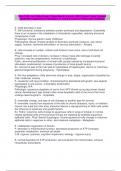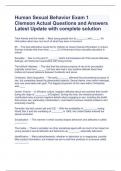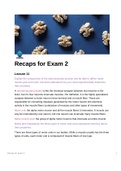Nurs 5315: Adv Patho Exam 1 | Questions & Answers (100 %Score) Latest Updated
2024/2025 Comprehensive Questions A+ Graded Answers | With Expert Solutions
E. Cells decrease in size
P. Still functional; imbalance between protein synthesis and degradation. Essentially
there is an increase in the catabolism of intracellular organelles, reducing structural
components of cell
Physiologic: thymus gland in early childhood
Pathological: disuse (muscle atrophy d/ decrease workload, pressure, use, blood
supply, nutrition, hormonal stimulation, or nervous stimulation) - Atrophy
E: cells increase in number, mitosis (cell division) must occur, size of cell does not
change
Phys: increased rate of division, increase in tissue mass after damage or partial
resection; may be compensatory, hormonal, or pathologic
Patho: abnormal proliferation of normal cells usually caused by increased hormonal
stimulation (endometrial). increase of production of local growth factors
Ex: removal of part of the liver lead to hyperplasia of hepatocytes. uterine or mammary
gland enlargement during pregnancy - Hyperplasia
E. Not true adaptation; Cells abnormal change in size, shape, organization (classified as
mild, moderate, severe)
P. caused by cell injury/irritation, characterized by disordered cell growth. aka atypical
hyperplasia or pre-cancer, a disorderly proliferation
Physiologic: N/A
Pathologic: squamous dysplasia of cervix from HPV shows up on pap smear, breast
cancer development; pap smears often show dysplastic cells of the cervix that must
undergo laser/surgical tx - Dysplasia
E: reversible change, one type of cell changes to another type for survival
P: reversible; results from exposure of the cells to chronic stressors, injury, or irritation;
Cancer can arise from this area, stimulus induces a reprogramming of stem cells under
the influence of cytokines and growth factors
Ex: Patho: Columnar cells change to squamous cells in lungs of smoker or normal
ciliated epithelial cells of the bronchial linings are replaced by stratified squamous
epithelial cells.; Phys: Barrett Esophagus- normal squamous cells change to columnar
epithelial cells in response to reflux, aka intestinal metaplasia - Metaplasia
E. inadequate oxygenation of tissues
P. decrease in mitochondrial function, decreased production of ATP increases
anaerobic metabolism. eventual cell death.
C.M. hypoxia, cyanosis, cognitive impairment, lethargy - Hypoxia injury
E. normal byproduct of ATP production, will overwhelm the mitochondria- exhaust
intracellular antioxidants
,P. lipid peroxidation, damage proteins, fragment DNA
C.M. development in Alzheimer's, heart disease, Parkinson's disease, Amyotrophic
Lateral Sclerosis - Free radical and ROS
E. mood altering drug, long term effects on liver and nutritional status
P. metabolized by liver, generates free radicals
C.M. CNS depression, nutrient deficiencies-Mag, Vit B6, thiamine, PO4, inflammation
and fatty infiltration of liver, hepatomegaly, leads to liver failure irreversible - Ethanol
Na and H2O enter cell and cause swelling. Organ increases in weight, becomes
distended and pale. Associated with high fever, hypocalcemia, certain infections -
Oncosis
Liver and germ cell tumors - Alpha Fetoprotein Origin
GI, pancreas, lung, breast tumors - Carcinoembryonic Antigen
prostate tumors - Prostate Specific Antigen
from epithelial tissue- renal cell carcinoma - Carcino-
from connective tissue- chondrosarcoma - Sarco-
preinvasive epithelial malignant tumors of glandular or squamous cells- cervix -
Carcinoma in situ
Multiple organs including brain - Lung ca metastasis
Liver, lungs - Colorectal ca metastasis
Liver, lungs, brain - Testicular ca metastasis
Bones (especially lumbar spine), liver - Prostate ca metastasis
Liver, bones, lymphatics - Head and neck ca metastasis
Peritoneal surfaces, diaphragm, omentum, liver - Ovarian ca metastasis
Lungs - Sarcoma metastasis
In transit lymphatics, lung, liver, brain, GI tract - Melanoma metastasis
Local invasion, followed by invasion of surrounding tissues. Cells then may invade
blood and lymphatic vessels. They must survive in circulation, then enter and survive in
a new location. Then the cells can multiply and form a new tumor. - Mechanisms of ca
metastasis
, T= tumor size >/= correlates with metastatic ability
N= whether lymph nodes are involved
M= extra nodal involvement (liver, lungs) - TNM staging system
In venous system- 20% - Intravascular fluid compartment
The measure of solute concentration in a fluid.
280-295 mOsm - Osmolality
Surrounds the cells and bathes them in nutrients- 20% - Interstitial fluid compartment
Within the cells- 40% uk - Intracellular fluid compartment
Passive- the movement of water from an area of low concentration of solute to one of
higher concentration - Osmosis
Pulling- the amount of pressure or force that is exerted by solute molecules of a given
compartment - Osmotic pressure
Blood pressure- pushes fluid outside of the vessels, the force of fluid against the walls
of a compartment- venous obstruction, Na and water retention - Hydrostatic pressure
Colloid pressure keeps water inside the compartment, attracts water from interstitial
space back into the capillary- losses or diminished albumin - Oncotic pressure
The amount of blood within the arterial space- ECF changes will cause changes in the
EABV in the same direction - Effective arterial blood volume
Activated by low blood volume, triggers release of renin which converts
angiotensinogen to angiotensin 1. ACE converts angiotensin 1 to angiotensin which
causes arterial vasoconstriction and stimulates release of aldosterone. Aldosterone
stimulates renal Na reabsorption and K+ excretion. Water is retained, less urine is
produced, blood volume increases. - Renin Angiotensin Aldosterone System
ANP and BNP- released by heart- works opposite RAAS to decrease blood volume,
promotes urinary excretion of Na and water - Natriuretic hormones
Dehydration- intake is not enough for body's needs
C.M. Poor skin turgor, dry mucous membranes, sunken eyes, sunken fontanelles,
decreased urine output, fatigue - Fluid volume deficit
Fluid intake exceeds body's needs
C.M. Edema, rales, HTN, weight gain, bounding pulses, intake> output, JVD,
restlessness or anxiety - Fluid volume excess






